- Email : info@lifeclivut.eu
Notícias e Eventos
THE SEED "THERMOMETER"
How do the seeds germinate?
Or, rather, how do they decide when it's time to sprout?
In the initial phase, a seed is defined as dormant, that is, it contains everything needed to germinate; Generally, after a few days from its formation, the germination process begins but not all seeds are the same, some, based on the conditions in which they find themselves, decide whether or not to germinate at that particular moment.
This is explained by a study published in "Nature Communications" in which it is clear that yes, the seeds have their own internal thermometer.
The model used in the study was based on the species Arabidopsis thaliana, commonly called arabetta, a plant now widespread throughout the world and used as a model in botanical studies; The seeds of this species generally "activate" when the temperature is ideal and are able to block depending on the variations, especially when they are in the order of 1-2 degrees.
This ability, analyzed by the Swiss team that conducted the study, is also visible in the adult phase of the plant, or its ability to orient itself depending on the position of the sun.
An analysis of arabetta seeds revealed that the production of the protein "phytochrome B" is delegated to the endosperm and not to the embryo itself; This suggests that if the endosperm is not present, the tissue that surrounds the embryo of the semen, the embryo itself becomes unable to block its growth and risks developing even at temperatures unsuitable for its survival.
FOCUS:
The term phytochrome refers to a green-blue chromoprotein present in plant organs that has the function of regulating some physiological processes such as induction to anthesis, seed germination, etc.
The discovery of phytochrome dates back to 1959 when it was indicated and cataloged as a substance by Butler and collaborators; However, its properties were known since the 30s thanks to experimental studies on plant responses to environmental stimuli
DOES CLIMATE CHANGE HAVE AN IMPACT?
As global temperatures rise, more and more plants will be able to grow in places too hot for them, including those grown for food production.
Click here for download
























